6. Yes they do squish your boobs
A) BUT they Compress Because They Care
OK, I know that the compression of the breast is what most women worry about before their first mammogram and while I will be the first to admit that the whole concept of squishing a woman's breast between two plates may seem a bit "intrusive" to say the least, it extremely important for several reasons. For one, it makes the breast thinner so a lower radiation dose is required, it spreads out the breast tissue so it can be better viewed on a 2-D image and it holds the breast still to eliminate motion. Below is a picture of a compressed vs uncompressed breast.
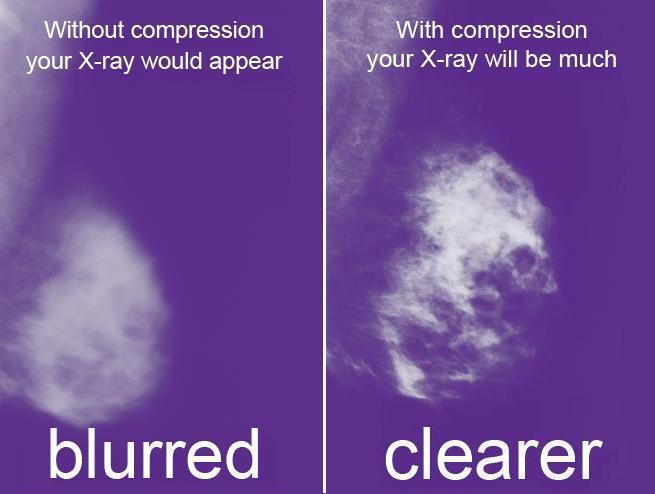
B) It WILL be Tight (and the Plates are a bit Cold)
Importance aside, there's no doubt that having an intimate part of your body pressed in a machine like that is a pretty unpleasant experience. Having had a mammogram, it's pretty hard to explain what it feels like since there really isn't much to relate it to. For those of you who don't know the compression is controlled by a pedal. My technologist first held the paddle down until my breast was in place, then she tapped it to get it flatter and she then finished by adding slightly more compression with a knob on the side of the paddle.
I felt a tugging sensation when the tech pulled my breast onto the cassette and it was cold when my technologist placed my boob on it and when she first brought the compression paddle down I did feel a tight squeeze on the part of my breast close to my chest. When she started tapping the paddle the squeeze felt tighter and I felt an "expansive" pressure on the front of my breast but then when she started turning the knob the front of my breast started to feel numb (kinda like having your Blood pressure taken on your breast). The numb sensation was interrupted when I felt the plates come into contact with my areola and it again felt cold. Well that's the best way to describe the sensation.
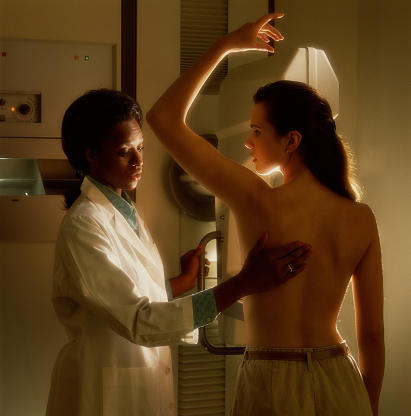
C) Done Properly, it WILL be Uncomfortable but it Shouldn't Hurt
Before my mammogram, my tech was so nice to explain it to me why it shouldn't hurt. Contrary to popular belief, a harder squeeze doesn't mean a better image, a flatter breast does. An analogy would be slowly pinching the skin on your arms. When you pinch the section of skin it gets thinner and thinner until you get to a point where the skin won't get any thinner and it just starts to hurt. This is because skin (and breast) tissue has a set elasticity. Think of it like when you stretch a rubber band.
It usually snaps back after you release it but if you pull to hard it starts to tear. It's the same thing with your skin; damage to body tissues causes pain and when you've stretched it beyond the limit of it's elasticity, the connective tissue becomes strained. It's the same thing with your breasts. When the compression paddle comes and flattens the breast it stretches the coopers ligaments of the breast tissue but once they've reached the limit of their elasticity, they can't be stretched any further and adding more force will only strain it. So adding pressure beyond the point that the skin on the breast becomes taught will only hurt the patient without improving the image quality.
Now it is true that breasts are more sensitive than arms so squeezing it and stretching the coopers ligaments will cause discomfort. So the bottom line is this (assuming your breasts aren't tender), if the compression hurts, the tech is squeezing to hard BUT if you don't feel any discomfort, she's not squeezing hard enough and you should be worried that the image quality is going to be compromised.

D) Don't Worry, Your Boobs Don't Stay Flat
Something a lot of women worry about is that a mammogram will cause their breasts to sag. But remember the rubber band analogy? When you stretch a rubber band and then release it it goes right back to its original shape. It's the same thing with the connective tissue of the breast; when the compression paddle releases (which it automatically does when the image is taken) your breast pops bail into it's original shape. And that feeling when it releases you, #Bliss

7. But there are ways you can get the most out of it
A) Relax During the Procedure
If you tense up when getting a mammogram because you're worried about it hurting, your tense pectoral muscle will put additional strain on the connective tissue of your breast and it "hurting" will become a self fulfilling prophecy. If you relax it will relive the strain on the connective tissue and a) you get a more pleasant experience and b) the tech gets more breast onto the cassette for the image (it's a win win). Also, if you go into the exam, expecting it to be uncomfortable, you won't tense up when you experience discomfort. There's also no reason to be embarrassed, the mammotechs perform dozens of these exams every day and behave in a very manner-of-fact way but are still humorous.
B) Breath Through Your Stomach
Taking deep breaths helps you relax during the procedure. But make sure to breathe through your stomach because the less your chest is moving, the easier it will be for the tech to position you. Also you have to hold your breath when the exposure is made.
C) Talk to the Mammotech
Before the procedure, feel free to ask your technologists about any questions or concerns you may have which will help to put your mind at ease. Also, if it starts to hurt, tell your technologist. Ideally, the breast should be taught but if it starts to hurt before then, it may be because a fold of skin is causing extra tension and the technologist can re position you to fix it. But going back to 6C, if you don't feel discomfort when she's finished applying compression, tell her to squeeze harder!!! Remember that when it comes to cancer detection, what you don't know can kill you!
D) Don't Look Down!!!
If you've ever seen what a breast looks like in a mammogram machine it looks pretty bad. But it looks 10x as bad as it actually is and trust me, you don't want to see your goodness mushed in a machine like that anyway.
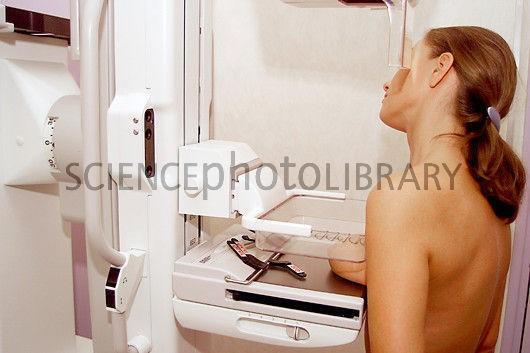
8. You will get special consideration if you fall into one of these categories
A) If you're "Large" Expect Extra Views
For women with large breasts, extra views may be required. This is for two reasons: 1 they can't get the breast as thin and portion of breast closer to the cassette will be smaller. 2, they may not be able to fit all of it onto the cassette. For me they took two extra views. Instead of the usual CC view my tech had an XCCL view where I stood at an angle to the cassette so more of the lateral (outer) portion of the breast was imaged and a cleavage view (CV) where part of the other breast being imaged was included to get the inner (medial) portion of the breast in the image. And on top of the LMO view my tech took an LM view where the machine was tilted 90 degrees with the cassette in-between my breasts and the compression paddle came in from the lateral side to squeeze it.
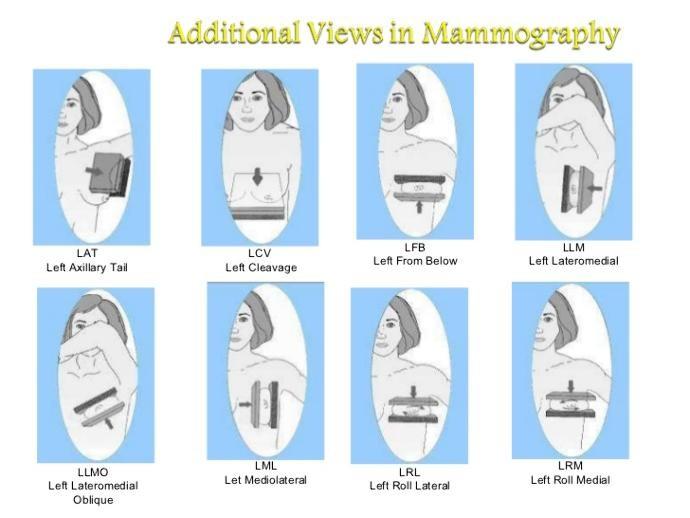
B) If you're "Flat" Different Equipment May Be Used
A commonly asked question is whether or not you can have boobs too small to squish and the answer is no. But to make it easier for the technologist to get as much tissue as possible, a smaller paddle is used that is as wide as the other ones but not as "thick" so on the other side of the cassette from the breast being imaged, it will be easier for her to manipulate the breast. Also, if the breast is too small, a rubber spatula may be used to hold the breast in place until compression can be applied.
C) If you're "Artificial" Duplicates are Taken
For women with breast implants, and additional version of each view is taken. First the standard view that includes the implant is taken. Then the implant is pushed back behind the cassette so the implant displaced or "Eklund" view can be taken.
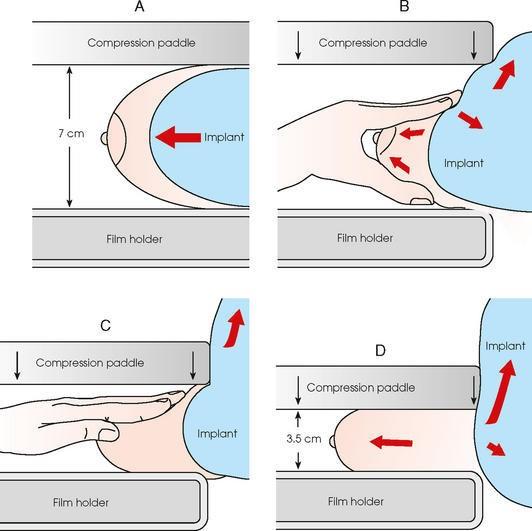
D) When it comes to Discomfort, Size Doesn't Matter
For anyone worried about getting a mammogram because you think it'll hurt more because you're flat or big chested, don't be. My tech explained this as well. Yes, they squeeze harder for the larger chested ladies and lighter for the small chested girls, but because it's spread out over a larger area for girls with large breasts (and a smaller one for those with smaller ones) the pressure on the breast (force per unit area) is the same so the nerve endings will be firing with the same intensity and regardless of size, everyone has the same amount of nerve endings in their breast (well the nipple has a set number of nerve endings per unit area so a larger nipple will have more nerve endings but during a mammogram, they don't squeeze the nipple) so it would feel the same for everybody.
9. Don't be afraid if you get called back
A) Most of the Time it's Nothing
About 10% of mammograms will result in a call back for additional tests. But of these only 5% will result in a cancer diagnosis. So if you get the return call don't lose your cool.
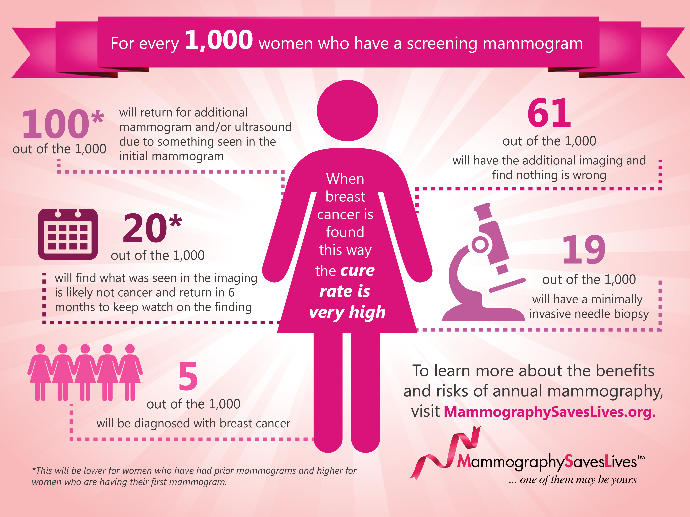
B) A Diagnostic Mammogram May Be Performed
A diagnostic mammogram is a more in depth mammogram to investigate a site of concern. Usually it will include views at different angles of the site in question. Also spot compression and magnification views may be performed. The spot compression just uses a smaller paddle to better resolve the area in question and the magnification view has the breast elevated above the cassette so when it reaches the cassette the x-ray image is expanded.

C) Or an Ultrasound
A breast ultrasound is a device that sends sound waves into the breast. When they bounce back the echos provide an image of the internal structures of the breast. A gel is applied to the breast to allow the sound waves to travel to the breast and a transducer is rubbed over it to send the sound waves. While its resolving power is not as good as a mammograms, it can determine the internal consistency of the structures of the breast (for example if a lump is filled with fluid or solid).
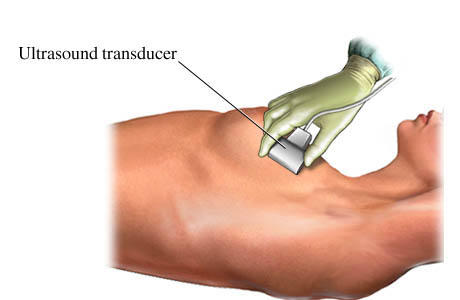
D) From there they May Order a Biopsy
Of the 10% of women called back for an additional imaging, 19% will need a biopsy. For this you will lay down on a table with a whole for the breast to fit into. A numbing solution will be injected into the breast and it will be compressed and X-rayed to determine the position of the mass in question. Then a needle is inserted into the mass and some of the cells will be removed and tested to determine if they are cancerous.

10. Remember that Mammograms Are a Girls B(r)e(a)st Friend <3
A) Always Give Your Mammotech a Hug Afterward
Dealing with nervous patients all day can be a tolling job but knowing that they made a difference in your life can make the job as a mammotech so rewarding.
B) Tell A friend to Get a Mammogram
Always encourage your friends and loved ones to get mammograms done. If they're afraid of the pain, tell them (if you had them done) it's 100% tolerable. If they're afraid that they'll find something, tell them to find it sooner than later for the people that they love. Offer to accompany them to the exam for comfort. Also tell them not to wear deodorant on the day of the exam and if they're breastfeeding, PUMP FIRST!!!
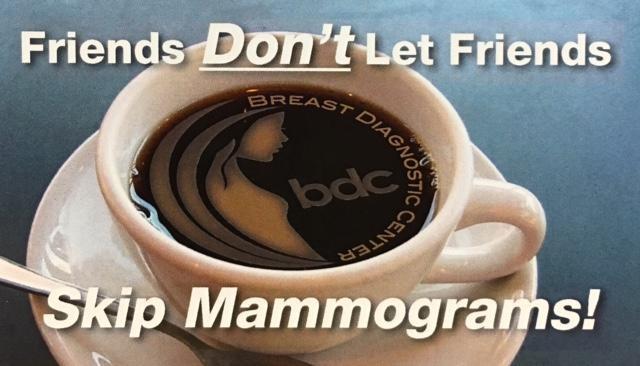
C) Men can get Mammograms Too
Even though mammography has many proven benefits, all over the internet, I see posts like this "This, combined with the constant stories from women who have them on how uncomfortable, painful, and humiliating mammograms are, make me suspect the entire purpose of this mammogram scam is to sexually torture women and get away with it." And "Can you imagine the whining we would hear if men had to screen for testicular cancer by having their balls put in machine that compresses them like pancakes?" and basically arguing that it's somehow "unfair" that we have to subject ourselves to this kind of test while men don't.
I personally get very upset when I read things like that for several reasons. First of all, you would be very hard-put to argue that testicular cancer is the "male equivalent" of breast cancer. What is you may ask? well, strictly speaking, there isn't one for one simple reason: men get breast cancer and for diagnostic purposes they do perform it on men. I talked to my tech about this and she (apart from confirming that it was a man who invented this machine) said that yeah she performed mammograms on male patients and remember what I said about how everyone has the same amount of nerve endings in their breast? Well, that applies to men to so it wouldn't be any more painful for a man than a woman.

D) Mammograms are a Blessing for Women, NOT a curse.
However, I guess if you where to argue that there is a demographic equivalent of breast cancer in men it would be prostate cancer and they indeed don't have to put their junk in a vice grip to image the prostate for screening purposes because there is no exam that can image the prostate for screening purposes. And to clarify, a digital rectum exam isn't the equivalent of a mammogram because it doesn't image the prostate, the doctor merely palpates with his finger; i.e it would be the equivalent of a manual breast exam.
And this is why I get so upset when people make this comparison: as I mentioned, breast cancer runs in my family but the genes that are responsible for causing hereditary breast cancer in women also cause prostate cancer in men. In fact, 3 years ago my favorite cousin died at the age of 33 from prostate cancer and if there was a screening tool that could image the prostate to look for cancer they might have caught it early enough and he might still be alive.

So, it's in this light that I would hope women would view mammograms as a blessing rather than some terrible procedure that has been unfairly imposed on us and to be thankful that we have this sort of technology available to help catch early and better treat breast cancer. And if I ever did meet the man who invented the mammogram, I would thank him so much for saving my mother's, sister's and probably one day my own life <3 <3 <3

-From an aspiring mammographer :)
 Holidays
Holidays  Girl's Behavior
Girl's Behavior  Guy's Behavior
Guy's Behavior  Flirting
Flirting  Dating
Dating  Relationships
Relationships  Fashion & Beauty
Fashion & Beauty  Health & Fitness
Health & Fitness  Marriage & Weddings
Marriage & Weddings  Shopping & Gifts
Shopping & Gifts  Technology & Internet
Technology & Internet  Break Up & Divorce
Break Up & Divorce  Education & Career
Education & Career  Entertainment & Arts
Entertainment & Arts  Family & Friends
Family & Friends  Food & Beverage
Food & Beverage  Hobbies & Leisure
Hobbies & Leisure  Other
Other  Religion & Spirituality
Religion & Spirituality  Society & Politics
Society & Politics  Sports
Sports  Travel
Travel  Trending & News
Trending & News
Most Helpful Opinions